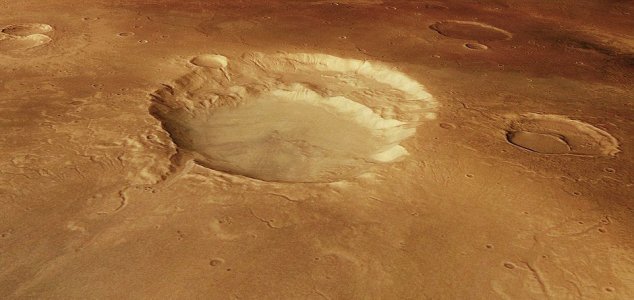Space & Astronomy
May 22, 2015 · 15 comments
15 comments

Image of the caldera taken by Mars Express. Image Credit: CC BY-SA 3.0 ESA/DLR/FU Berlin
Now scientists at the European Space Agency have found new evidence to suggest that these apocalyptic eruptions might have also taken place on Mars as well.
Measuring 40km across at its widest point and with a maximum depth of 1750km the Siloe Patera crater might not look like much at first glance, but by analyzing photographs captured by the Mars Express orbiter scientists now believe that it was formed by an ancient supervolcanic eruption.
Unlike the typical cone-shape that tends to characterize a volcano, supervolcanoes leave a large hole in the ground because the huge explosive eruption happens so quickly.
While it can be difficult to tell the difference between a caldera and an impact crater, in this case experts believe that a caldera is more likely due to the structure of the crater walls.
A second smaller crater inside the first could also indicate multiple eruptions.
"A number of irregularly shaped craters have been detected in the Arabia Terra region that could represent a family of ancient supervolcano calderas," ESA wrote on their website.
"Siloe Patera is one such example. It is characterized by two depressions with steep-sided walls, collapse features and low topographic relief."
Source: Russia Today | Comments (15)
ESA discovers ancient supervolcano on Mars
By T.K. RandallMay 22, 2015 ·
 15 comments
15 comments
Image of the caldera taken by Mars Express. Image Credit: CC BY-SA 3.0 ESA/DLR/FU Berlin
The Siloe Patera crater on Mars is now believed to be the collapsed center of an enormous volcano.
Last month scientists discovered a huge magma chamber deep below Yellowstone National Park containing up to 116,000 cubic kilometers of molten rock. While the chances of a supervolcanic eruption in the foreseeable future are slim, such events are known to have occurred multiple times throughout our planet's history.Now scientists at the European Space Agency have found new evidence to suggest that these apocalyptic eruptions might have also taken place on Mars as well.
Measuring 40km across at its widest point and with a maximum depth of 1750km the Siloe Patera crater might not look like much at first glance, but by analyzing photographs captured by the Mars Express orbiter scientists now believe that it was formed by an ancient supervolcanic eruption.
Unlike the typical cone-shape that tends to characterize a volcano, supervolcanoes leave a large hole in the ground because the huge explosive eruption happens so quickly.
A second smaller crater inside the first could also indicate multiple eruptions.
"A number of irregularly shaped craters have been detected in the Arabia Terra region that could represent a family of ancient supervolcano calderas," ESA wrote on their website.
"Siloe Patera is one such example. It is characterized by two depressions with steep-sided walls, collapse features and low topographic relief."
Source: Russia Today | Comments (15)

The Unexplained Mysteries
Book of Weird News
AVAILABLE NOW
Take a walk on the weird side with this compilation of some of the weirdest stories ever to grace the pages of a newspaper.
Click here to learn more

Support us on Patreon
BONUS CONTENTFor less than the cost of a cup of coffee, you can gain access to a wide range of exclusive perks including our popular 'Lost Ghost Stories' series.
Click here to learn more
Science and Technology
Russia and the War in Ukraine
True Crime
Ancient Mysteries and Alternative History
Total Posts: 7,780,022 Topics: 325,668 Members: 203,951
Not a member yet ? Click here to join - registration is free and only takes a moment!
Not a member yet ? Click here to join - registration is free and only takes a moment!




































Please Login or Register to post a comment.